
Super Phénix: Creys-Malville Nuclear Power Station, River Rhone (Sur le Rhone) Creys-Malville, Isere, France, Centrale Nucleaire Europeenne a Neutrons rapides SA. Wall chart insert, Nuclear Engineering International, June 1978
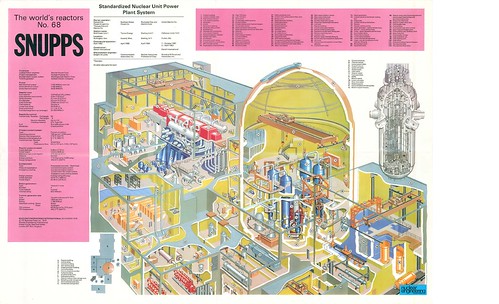
Snupps (Standardized Nuclear Unit Power Plant System): Kansas City Power & Light Co., Burlington, Kansas. Wall chart insert, Nuclear Engineering International, November 1975
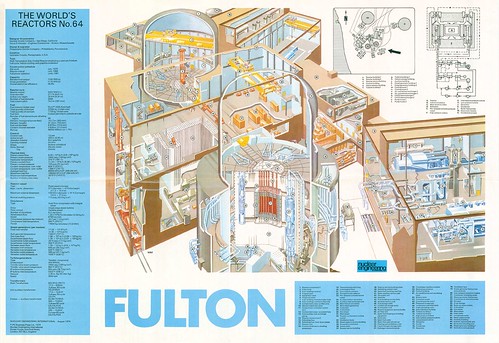
Fulton: Lancaster County, Pennsylvania, U.S.A., Philadelphia Electric Company. Wall chart insert, Nuclear Engineering International, August, 1974.
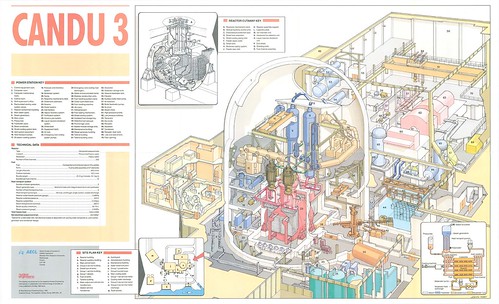
Candu 3: Mississauga, Ontario, Canada, CANDU Operations, Atomic Energy of Canada Ltd. Wall chart insert, Nuclear Engineering International, May 1990.

Douglas Point BWR/6: Potomac Electric Power Company, Douglas Point, Maryland. Wall Chart insert, Nuclear Engineering International, November 1973.

Grand Gulf: Middle South Energy Inc./Mississippi Power and Light, near Port Gibson, Mississippi. Wall chart insert, Nuclear Engineering International, September 1980.
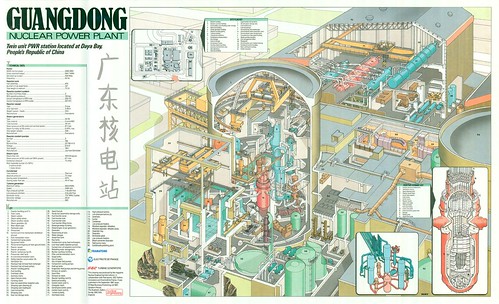
Guangdong Nuclear Power Plant: Twin unit PWR station located at Daya Bay, People's Republic of China. Wall chart insert, Nuclear Engineering International, September 1987
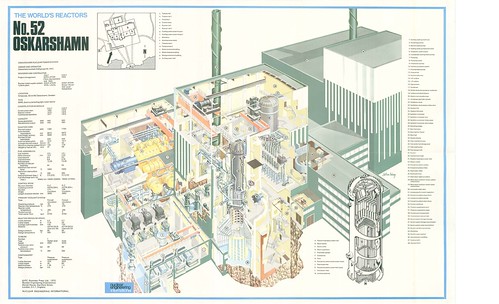
Oskarshamn: Simpevarp, Sweden, Oskarshamnsverkets Kraftgrupp AB, OKG. Wall chart insert, Nuclear Engineering International, 1970.
[Click through for large and very large versions]
These images are derived from pdf files [UNM CSEL Nuclear Engineering Wall Chart Collection] hosted on New Mexico's Digital Collections portal for the Centennial Science and Engineering Library at the University of New Mexico on behalf of NEI. Something a bit different, to be sure.
In the same vein, I posted a link on Twitter the other day to the Flickr cutaway pool.
The Kevin Hulsey site can never be over-linked.
Addit: For the very keen, MIT has lecture notes and slides (I haven't looked) for the Integration of Reactor Design, Operations, and Safety course available. But maybe it's only tangential at best.
I would love to find more in the way of technical / industrial drawings and designs if anyone has a link to share?
**UPDATE** - See the later BibliOdyssey post, Nuclear Reactor Cutaways (from the expanded New Mexico collection as above).
Friday, December 18, 2009
Nuclear Reactor Wall Charts
Liber Chronicarum
The Nuremberg Chronicle
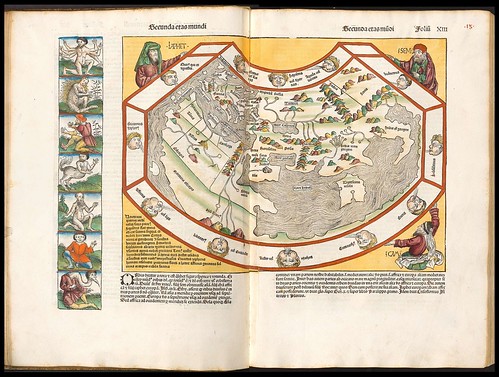
The famous world map from Hartmann Schedel's 'Nuremberg Chronicle', in the style of Ptolemy, leaves out Scandinavia, East Asia and the southern reaches of the African continent, yet includes a large island off the west African coast. The sons of Noah (Shem, Japhet and Ham: they populated the earth following the great - biblical - flood) are illustrated around the outside of the map.
The curious figures on the left include a centaur, a cyclops and various other fanciful characters and monsters, derived from early travellers' tales such as Pliny the Elder's first century AD epic, 'Natural History' and, perhaps, from the popular 'Romance of Alexander' legends. The implication being that strange creatures dwell in far away places. [zoomable b&w version]

City map of Florence

City map of Nuremberg

Germanocentric map of central Europe

The city map of Venice includes the palace of the doge (duke), St. Mark’s Basilica, the Campanile (bell tower) and other landmarks still visible today.

An imaginary view of the destruction of Jerusalem in one of the earliest maps of that city. The design is likely a collaboration between Felix Fabri, who had visited the Holy Land in 1480, and the author/woodcut artists who produced 'Liber Chronicarum' (Book of Chronicles)
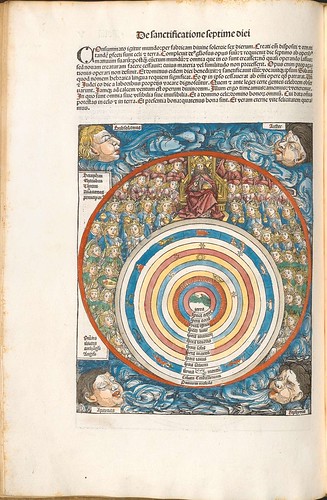
Geocentric view of the universe, including the four elements (air, fire etc) and the hierarchies of cherubims and seraphims, leading to God

The heavenly chorus of angels
"The text describes different ancient Greek theories of creation before dismissing them for the biblical account found in Genesis. The woodcut, however, critiques the text's view of the Greek theories as ancient errors by reinstating the most important Greek concept, that of hyle, the primeval matter from which all things are formed (the stylized gothic letters at the center of the woodcut spell 'YLE'). The artist of this illustration, in fact, has literally made the Greek idea of hyle central to the creation story."
God the Father seated on a throne surrounded by the firmament. Cherubs cavort in the heavens above and two ?devilish creatures holding armorial crests are at the bottom. The banderole reads: "God said Let there Be and all things were made" (other versions {same woodcut}: one & two)

(I presume this is) the Assumption of the Blessed Virgin Mary
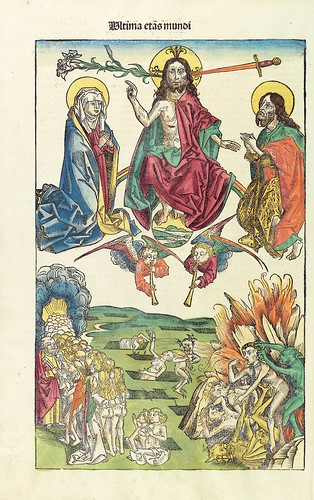
The last Judgement (Ultima Etas Mundi). Christ on an orb flanked by St.John and the holy Virgin. The lily of mercy and the sword of justice are on either side of Christ's head. Two angels with trumpets are waking the dead from their graves. St Peter leads the majority to heaven, while devils drag off the remainder to hell.

This woodcut depicts the murder of Simon of Trent in 1475 surrounded by his alleged killers, a significant episode in anti-Semitic history [I totally thought this was the circumcision of Jesus at first]

The building of Noah's Ark

Double page spread showing the elaborate nature of the printing and woodcut layout

Organisational structure of the Holy Roman Empire

'Eneas Pius Papa -- Frideric(us) terci(us) romanor(um) i(m)perator'
The joint reign of Pope Pius II (reigned 1458-1464) and Emperor Frederick III (reigned 1440-1493) typifies the idea of the medieval Christian kingdom of compensation and reconciliation. The emperor had a divine order to secure peace with the Pope and justice in the world under the protection of his church.

'Concilium Nicenum' - which I take to mean a Papal convocation
Later: Most likely: First Council of Nicaea in 325 (thanks Jim!)
Later: Most likely: First Council of Nicaea in 325 (thanks Jim!)
The burning of Jews in the 14th century during the black death (bubonic plague). Jews were perceived as being less susceptible to the plague than their neighbours (likely the result of Jewish ritual regarding personal hygiene) and they were accused of poisoning Christian wells: thought to be the source of the plague. [see: Jewish History Sourcebook]

The apocalypse or armageddon, featuring the epic battle of good versus (some rather excellent depictions of) evil


[In most cases you can click through to enlarged versions; all the images with black borders were trimmed and spliced together; the descriptions are sometimes deductions so please let me know if there are any glaring errors]
One of the most important books in the history of printing, 'Liber Chronicarum' [Nuremberg Chronicle or Weltchronik] is an illustrated history of the world by Dr Hartmann Schedel with illustrations by Michael Wolgemut, his stepson Wilhelm Pleydenwurff and (probably) Wolgemut's apprentice, Albrecht Dürer. The printing was carried out in Nuremberg in 1493 by the renowned printer-scholar, Anton Koberger, first in Latin followed by a German edition a few months later.
"The Chronicle is probably the most sophisticated printed book published before the year 1500 [incunabulum] because of its use of different graphic layouts that integrate text and image in more varied ways than anything that had previously been attempted."
The book is divided into seven ages within a biblical timeline and narrative, and loosely incorporates historical events together with extended digressions that displays the author's personal interests.
"Schedel compiled this elaborate history of the world from “the first day of creation” to his own time in an effort to correct what he felt was a slight to German history by other chroniclers. He divided his work into the usual six ages of the history of mankind, adding a seventh in which he foretold the coming of the Antichrist, the destruction of the world, and judgment day." [source]
Over eighteen hundred illustrations appear in the book, compiled from about six hundred and fifty woodblocks. Many of the portraits appear multiple times and even some of the city maps are reused (some of those are imaginary views or adaptations from other artists and predictably, the closer to Nuremberg, the more accurate was the map).
- The vast majority of the images above were obtained from the Bavarian State Library.
- Others were obtained from Biblioteca Digital de Obras Raras e Especiais at Universidade de São Paulo, Brazil.
- The b&w image comes from the Polish Digital Library [or large thumbnail page of all the images].
- Wikimedia has a lot of illustrations in three categories: one, two, three; a few of which also appear above.
- Morse Library at Beloit College in Wisconsin have an extensive website devoted to 'Liber Chronicarum'. It remains the best background site online definitely. [w]
Sunday, December 13, 2009
Ainu Komonjo
"The Ainu are generally considered to be the indigenous population of Japan. But, like all cultures on earth, the history of the Ainu is much more complex than any one label. The 20,000 to 60,000 people who presently identify themselves as Ainu are concentrated on Japan's northern island of Hokkaido, but the Ainu culture once stretched up to the southern part of Sakhalin Island and the Kurile Islands (now part of Russia)."

"When the Japanese state was officially opened to outside influence in 1867, visiting Western scholars became fascinated by the Ainu they met in Hokkaido. They were struck by their "primitive" way of life, their "bizarre" rituals that involved the sacrifice of bear-cubs, the practice of facial tattooing, and their large amounts of body hair. Their facial features, when contrasted with the Japanese on the main island of Honshu, made them look positively Caucasian to these early scholars and explorers." [source]
The woodblock illustrations below were cherry-picked from a Wisconsin University collection of about forty books presenting the earliest depictions - from the 18th and 19th centuries - of the Ainu people by the Japanese. The images are in haphazard order and are primarily of the Sakhalin Ainu (pronounced eye-noo)
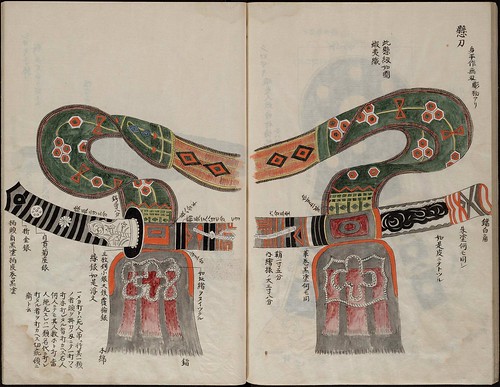
'Ezo-shi' by Arai Hakuseki (1720)
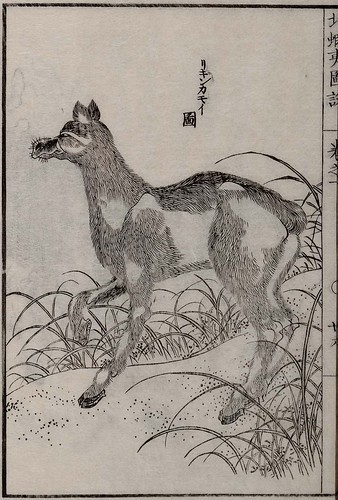
'Kita Ezo Zusetsu' vol. 1 by Mamiya Rinzō (1855)
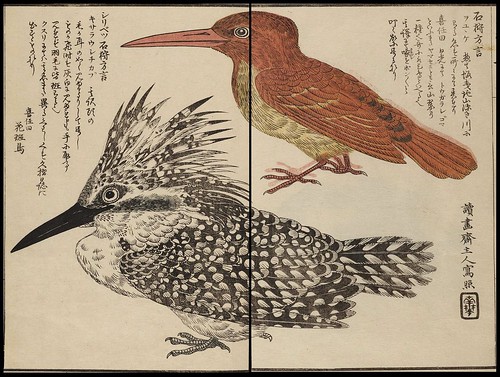
'Ishikari Nisshi' by Matsuura Takeshirō (1860)
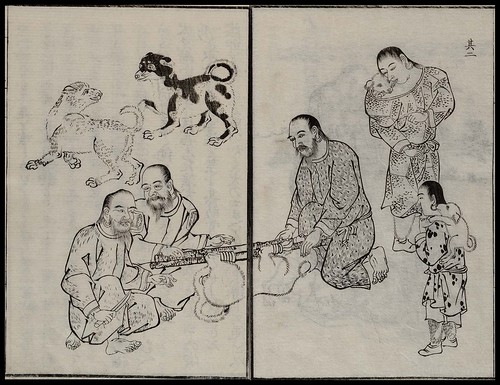
'Kita Ezo Zusetsu' vol. 2 by Mamiya Rinzō (1855)
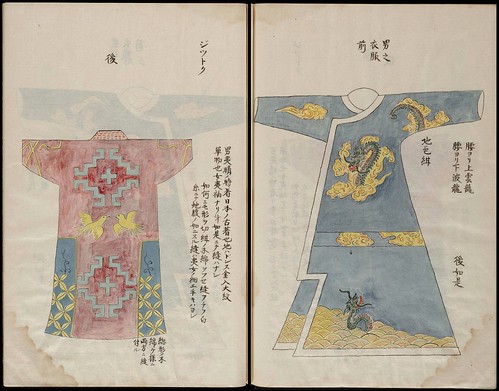
'Ezo-shi' by Arai Hakuseki (1720)

'Kita Ezo Zusetsu' vol. 2 by Mamiya Rinzō (1855)

'Kita Ezo Zusetsu' vol. 1 by Mamiya Rinzō (1855)

'Kita Ezo Zusetsu' vol. 2 by Mamiya Rinzō (1855)
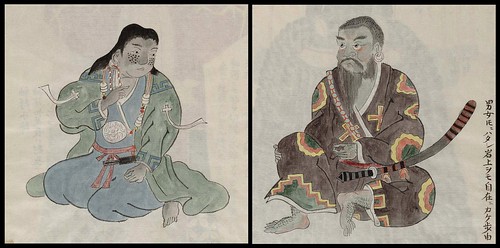
'Ezo-shi' by Arai Hakuseki (1720)
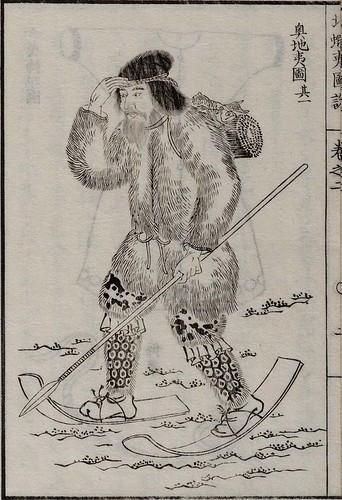
'Kita Ezo Zusetsu' vol. 2 by Mamiya Rinzō (1855)

'Henyō Bunkai Zukō' vol. 1 by Kondo Morishige (1804)
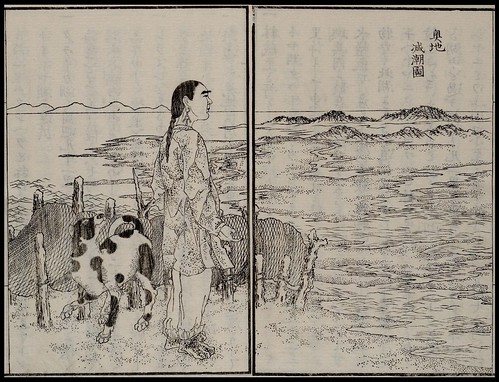
'Kita Ezo Zusetsu' vol. 1 by Mamiya Rinzō (1855)

'Henyō Bunkai Zukō' vol. 3 by Kondo Morishige
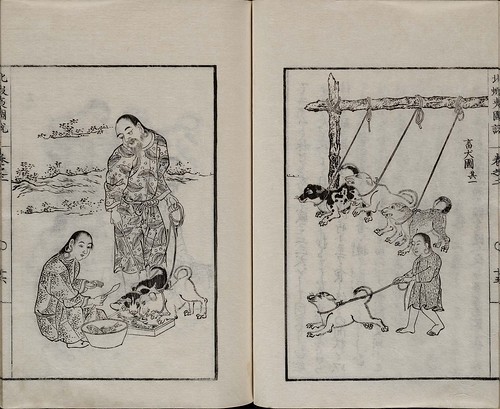
'Kita Ezo Zusetsu' vol. 2 by Mamiya Rinzō (1855)
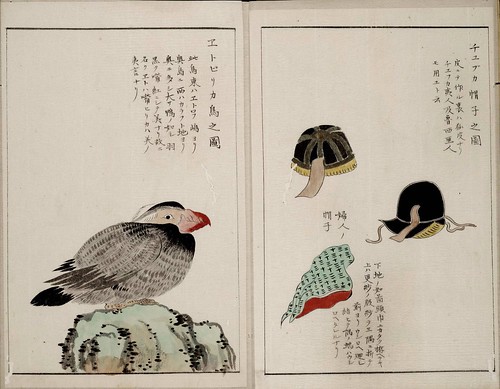
'Henyō Bunkai Zukō' vol. 4 by Kondo Morishige (1804)

'Kita Ezo Zusetsu' vol. 4 by Mamiya Rinzō (1855)

'Kita Ezo Zusetsu' vol. 4 by Mamiya Rinzō (1855)

'Henyō Bunkai Zukō' vol. 4 by Kondo Morishige (1804)
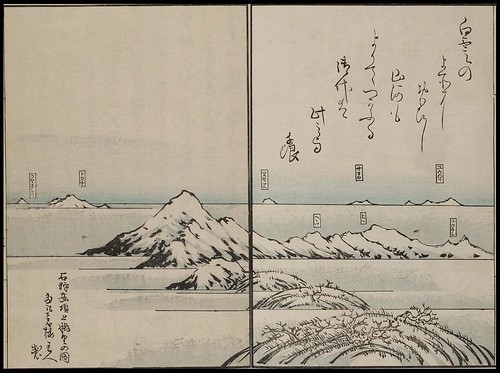
'Ishikari Nisshi' by Matsuura Takeshirō (1860)
[many of these images have been brazenly sliced, diced and modestly doctored for display purposes; click through for enlarged versions; there are a few more in the set]
"All the Ainu engaged in a hunting-gathering way of life. Men hunted and trapped land and sea mammals and other animals, and fished in rivers and sea. Women gathered root crops and other edible and medicinal plants. Although “art” was not a separate sphere of their activity, men were skilled carvers and women were talented in weaving and embroidery. Their oral tradition, both of the Sakhalin and Hokkaido Ainu, was highly developed and some scholars view their lengthy epics comparable to the Greek epics.
For the Sakhalin and Hokkaido Ainu, the bear is their supreme deity. They would catch a bear cub, nurture it and send its soul back to the mountains in an elaborate bear ceremony, which was not only a religious ritual to express their respect for the bear during which they feasted on its meat. It was also a political occasion to display the wealth and power of the political leader and his settlement." [continued]
- 'Ainu Komonjo (18th & 19th century records) -- Ohnuki Collection' is a new offering from the exceptional University of Wisconsin Digital Collections. Click 'Browse' - and once you get through to a specific volume, note the gallery (thumbnail) link in the sidebar.
- Ainu: Spirit of a Northern People feature at the Smithsonian National Museum of Natural History.
- The Boone Collection.
- "Japan's Ainu hope new identity leads to more rights" - CSM [2008]
- "Japan's native Ainu fights for cultural survival" AFP [Nov. 2009]
- Wikipedia / Flickr.


















